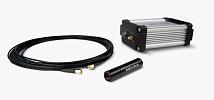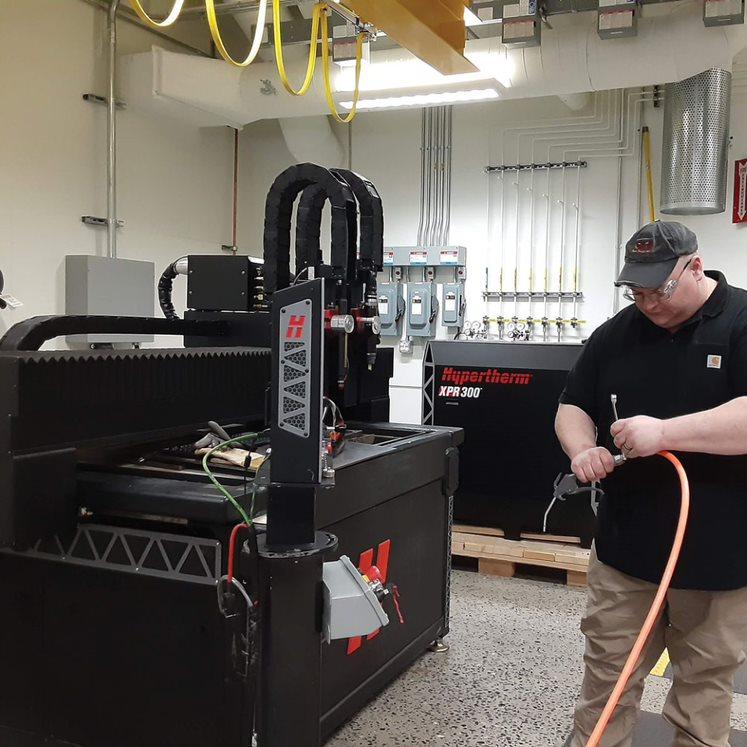- FMA
- The Fabricator
- FABTECH
- Canadian Metalworking
Manage your compressed air costs
5 steps that will reduce utility costs
- Updated June 8, 2020
- June 8, 2020
- Article
- Fabricating
Most shops depend on compressed air for general use. It’s great. You can power tools and run key processes like air filtration, sandblasting, and plasma cutting. However, because compressed air is everywhere (and truly invisible), it’s easy to overlook.
Business owners already know they need to keep an eye on the bottom line, but some overhead expenses become routine and, ultimately, just accepted. That’s what happened at Hypertherm. The manufacturer lost sight of how much money it was spending on compressed air and the electricity used to power those systems.
Production Realities
“We were surprised when we measured the electricity costs used for compressing air. It was one of our highest utility costs,” said Robin Tindall, an engineer on Hypertherm’s corporate social responsibility team. “The compressed air alone at one of our manufacturing buildings was costing us $10,000 a month. That’s hard to imagine.”
The facility Tindall is speaking about uses compressed air to assemble the company’s X-Definition and HyPerformance plasma power supplies, as well as to machine the plasma consumables used by both product lines. This facility is just one of eight manufacturing buildings in New Hampshire, and this expense is further multiplied when the company’s production facilities in Washington, Minnesota, and Italy are included. The point is, these costs add up fast.
A 5-point Plan
The company knew it needed to do something to reduce costs and save resources. Here’s what it did:
1. Turn it off
At the three-shift production facility, sometimes the equipment was left on when it wasn’t being used. Shutdowns were made a standard process, signage was posed, and indicator lights installed. Now employees know when and how to turn equipment off.
2. Use valves
Air compressors often power several machines at the same time. By installing or using existing valves, diverters, and slide gates, the company can shut off idle machinery easily.
3. Regulate pressure settingsBy checking instruction manuals and equipment gauges, operators dialed down pressure when the equipment was overpressurized. In one case, the compressed air was at 120 PSI when only 90 PSI was needed.4. Perform preventive maintenance
Check instruction manuals for maintenance schedules and perform maintenance regularly. Not only will it prevent unexpected breakdowns, but it will also improve equipment performance and efficiency. Employees now check and change compressor filters on time.
5. Find leaks
Leaks are common and can be hard to find. This can be frustrating, but worth the effort. One way to listen for leaks is to power off all the equipment but leave the air compressor on. Hypertherm did this on the weekends when the shops were closed. This helped them identify and replace leaky fittings and valves as well as worn hoses and pipes.
Helpful Tools
Free public resources are available to assist you with your compressed air questions. For instance, Natural Resources Canada (nrcan.gc.ca) has detailed information on its website about buying and operating compressed air systems.
In addition, in the U.S. the Compressed Air Challenge website, compressedairchallenge.org, offers useful information.
Business Advantages
Keeping a competitive edge is a real concern for every business. As a manufacturing company, Hypertherm needs to be rigorous when it comes to controlling production costs. Like all other manufacturers, it must identify ways to improve how it brings products to market. It’s a very dynamic process and one that requires ongoing commitment.
Rod Aldrich, a technician at a Hypertherm facility, knows this first-hand.
“Most production costs are out of my control, but the cost of compressed air is something I can impact with ongoing systems maintenance and monitoring,” he said. “It requires diligence, but diligence adds up to significant savings.”
It’s the persistent work of Aldrich and other associates that ensures the manufacturer does not spend more than it needs to on compressed air and electricity.
Article provided by Hypertherm Inc., www.hypertherm.com
subscribe now


Keep up to date with the latest news, events, and technology for all things metal from our pair of monthly magazines written specifically for Canadian manufacturers!
Start Your Free Subscription- Trending Articles
Aluminum MIG welding wire upgraded with a proprietary and patented surface treatment technology

Hypertherm Associates partners with Rapyuta Robotics

Protected and productive: welding helmet tech

HGG Profiling Equipment BV names Western Canada area sales manager

Compact weld camera monitors TIG, plasma processes

- Industry Events
CTMA Economic Uncertainty: Helping You Navigate Kitchener Seminar
- May 2, 2024
- Kitchener, ON Canada
Automate 2024
- May 6 - 9, 2024
- Chicago, IL
ANCA Open House
- May 7 - 8, 2024
- Wixom, MI
17th annual Joint Open House
- May 8 - 9, 2024
- Oakville and Mississauga, ON Canada
MME Saskatoon
- May 28, 2024
- Saskatoon, SK Canada
















